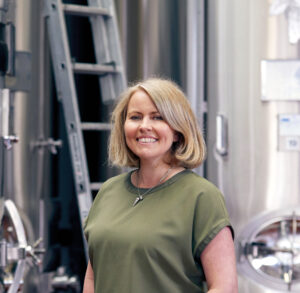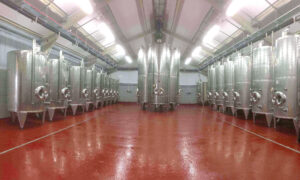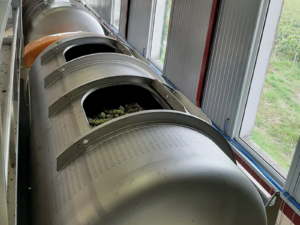Expert advice on how to start a winery
28th March 2023
Wineries are more than just barns in which to make wine. Emma Rice, consultant winemaker with Vinescapes, looks at the many options, considerations and pitfalls to be aware of when setting up a winery.

Emma Rice courtesy of Felicity Crawshaw 2022
Earning the enviable position as the fastest growing sector of agriculture, UK wine continues to see phenomenal growth, with millions of vines being planted each year, and a sparkling optimism within the industry. Once their vineyards are established, many growers begin dreaming of a winery – keen to see the fruits of their labours made into outstanding wines. However, visitors to wine regions around the world will have seen that, as well as being high tech food standard production facilities, wineries also need to reflect the wine brand – whether that is quirky or swanky, or upmarket and chic, as well as the business ethos.
Winery scoping and design
Wineries are facilities that are designed to produce top quality wines efficiently and cost-effectively. The winery design process starts with an in-depth scoping exercise with a team of professionals – including architects and winemakers, as well as experts in finance, regulations and planning.
The scoping exercise calculates the building, operational and storage space needed, based on the wine style and volumes to be produced – which then dictates the equipment, machinery, fermentation and storage tank specifications and capacity.
As well as production facilities, wineries are also potentially visitor ‘destinations’, which give the business opportunities for additional income and profit margins, with cellar door shops and tasting rooms, cafés and restaurants, or even holiday accommodation and these facilities need to meet requirements and the brand aspirations. The scoping will also consider expansion plans and future developments.
The team then work with planning experts, to develop the concept into the pre-planning design phase, taking into consideration the following requirements:
- Town planning and planning policy
- Environmental sensitivities such as site ecology and archaeology
- Connections to utilities and proximity of supplies
- Floor specification and drainage
- Wastewater treatment
- Energy efficiencies and renewables
- Regulations, bond and licensing requirements
- Key bodies such as The Environment Agency or Natural England
- Site topography, orientation and landscape impact.

Woodchester Valley winery. Image courtesy of BevTech Ltd.
Winery equipment
When planning permission has been obtained and the build is underway, it’s time to go shopping! However, the array of winery equipment is mind-boggling and the guidance of an experienced winemaker is essential. The starting point is deciding on the style of wine to be produced, as different equipment is required for still red or white wines, traditional method sparkling, charmat or frizzante so there are many options, either for specialist or flexible kit. It’s important to remember that most winery equipment is not ‘off the shelf’, and the lead times for delivery can be long.
Grape receival
When grapes arrive at the winery, they have the option to meet the triage table, grape elevator, destemmer, crusher, and press. The destemmer is used for still wines and separates the grape berries from the stems. The triage table is a vibrating sorting table to allow unwanted berries, leaves and other matter to be removed. The crusher is also used for still wines and is formed of two rollers that can be adjusted to lightly split the skins and open the berries before loading into the press or fermentation vessels. Grapes destined for traditional method sparkling wine are not destemmed or crushed, but are loaded into the press as whole bunches. However, grapes for charmat method sparkling wine can be destemmed and crushed.
Wine presses
The press is a piece of equipment with a significant price tag. It extracts juice from the grapes, but there are many types with different modus operandi – depending on the style of wine. Simply put, still wines are made from crushed fruit and sparkling from whole bunches (although some high quality still white wines are pressed directly from whole bunches), so a winery that is making both will need to have a press that has the capacity for the whole bunch proportion of the harvest. The pressing cycle for whole bunch fruit is about twice as long as that for crushed fruit, so operational capacity will need to be considered. Some wines may need inert presses, or closed tank presses. Also, specialist sparkling wine brands of press, such as a Coquards, are not suitable for still wine. A professional winemaker will be able to advise on the most suitable style and size of press for the winery and styles of wines.
Tanks
The tank capacity of a winery has to allow for fermentation, storage, movement and blending. Tanks for white wines have different specifications to red wine tanks. Charmat method sparkling wine requires specialist pressure tanks. White wine tanks, for still or sparkling base wines, need to have cooling and temperature control capabilities, for which there are several options. All tanks require the correct fittings and valves, site glasses, temperature and other control units to make workflow, use of hoses and pumps in the winery as efficient as possible.
White wine
If the grapes are destined for white or rosé wine, they can be destemmed and crushed before being loaded into the press; although whole bunches can be used for some styles. The press extracts the juice from the skins and seeds which is pumped into a tank for settling. The clearer juice is then racked from its solids into another tank for any winemaking adjustments or additions, before inoculation with yeast and temperature controlled alcoholic fermentation.
Sparkling wine
Grapes for traditional method sparkling wine are loaded as whole bunches into a specialist press which is able to separate the juice into different fractions – as this impacts the final quality of the sparkling wine. The juice is settled and pumped into a tank for its primary alcoholic fermentation – to produce the base wine. Rosé sparkling can be made by either blending with red wine before the secondary fermentation or by allowing red grapes to have some skin contact to produce a pink tinted juice. The secondary fermentation takes place in bottle and requires a process known as tirage, to add yeast and sugar to the base wine, before bottling into the ‘champagne’ style bottles.
Charmat does not require whole bunch pressing so can essentially be made like a white wine to produce a base wine. The secondary fermentation takes place in specialist pressure tanks.
One of the major challenges in winery design is allocating enough space for temperature-controlled storage for sparkling wine – particularly traditional method, which can spend between one and 10 years, or more, on its yeast lees in bottle after secondary fermentation – and then further storage under cork before sale. This area can be considerable!
Red wine
Red grapes are fermented in their skins to extract colour, tannins and flavour compounds, so they are usually destemmed and crushed, and then the ‘must’ is pumped into a tank for alcoholic fermentation. The pressing of reds takes place after this fermentation, to separate the wine from the skins and seeds.
Barrels
Red, white and sparkling base wines, depending on their desired styles, may have some time in oak. Oak barrels, depending on age and origin, impart different characters and flavours to the wine. If wines are to be oak aged, then barrel storage, handling and racking systems need to be planned for the winery. Storage also needs to be allocated to dry goods – such as bottles, closures and other packaging items, as well as wine ready for dispatch.

Wine press. Image courtesy of BevTech Ltd.
Winemaking equipment
After the grapes are processed and the wine in tank, there are several further stages in the winemaking process that requires specialist equipment. The wine needs to be cold stabilised, maybe filtered, fined and clarified, bottled, labelled and packed. Traditional method sparkling needs to be riddled (to settle the yeast) using riddling cages, and disgorged (to remove the yeast).
Labs and analysis
To ensure quality at each stage the grapes and wine need to be monitored and analysed, including sugars and acids, alcoholic and malolactic fermentations, SO2, final alcohol levels and more. The winery can include a fully equipped laboratory to provide speedy results, or samples can be sent away to an external laboratory.
Contract winemaking
A winery requires significant investment and for some producers a contract winery can be an attractive alternative, and the UK now has well-established contract winemaking services.
Aside from straight financial comparison between own production and contract winemaking one consideration is the skill level of staff. A smaller winery may not be able to afford a winemaker and cellar team with the same experience as a large contract winery.
Charmat method sparkling wine production requires investment in high tech pressure tanks and counter-pressure bottling equipment, so a specialist contract winery is an option for this
style of second fermentation.
Mobile services
It’s very exciting to set up a winery and get involved with every operation – but it can get very dull standing on a slow-operating bottling line all day! Sometimes it’s better to contract out some of the tasks – and have more time for selling the wine. These specialist mobile services will likely have better quality, faster-operating machinery, and equipment that a winery would find hard to justify – and the benefit of skilled operators.
Mobile services are a common feature in most wine regions around the world, and now the UK, as they make good business sense – it’s usually better to use a contract service rather than invest in high-cost capital equipment that is only used a few times a year. Contract services include mobile bottling, labelling, filtration, cold stabilisation and disgorging.
